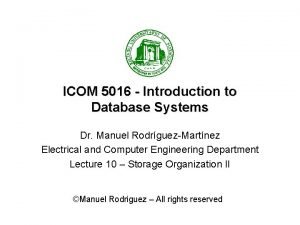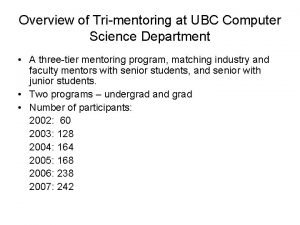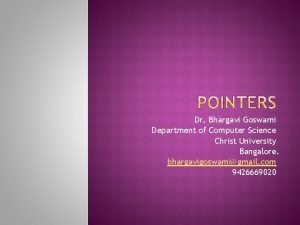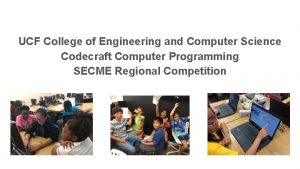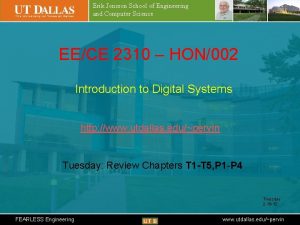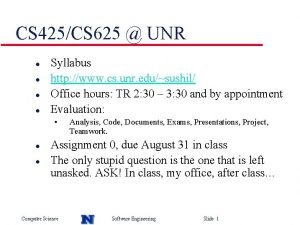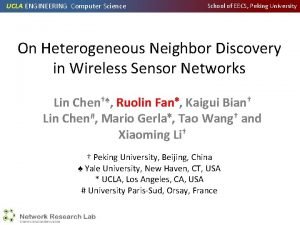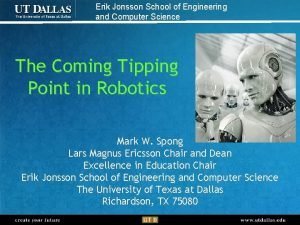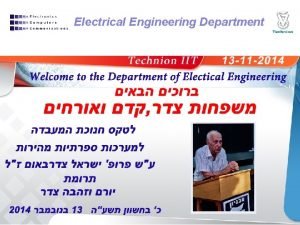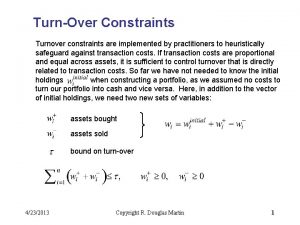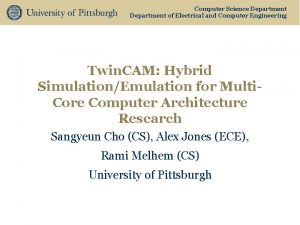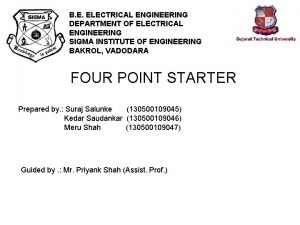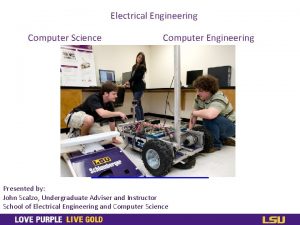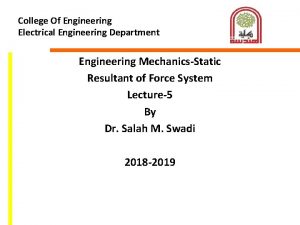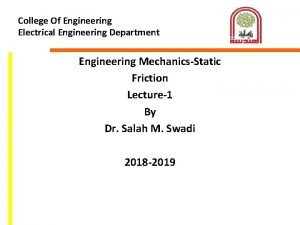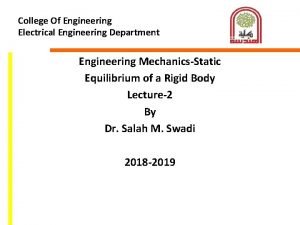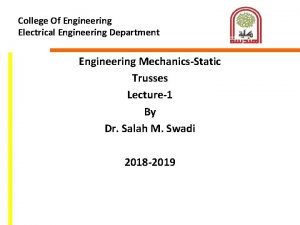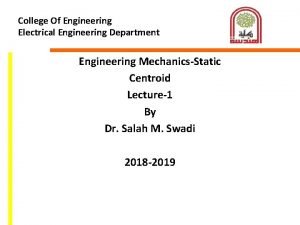Department of Computer Science and Electrical Engineering Turnover


















- Slides: 18

Department of Computer Science and Electrical Engineering

Turnover Education 15% Research 85% Employees: 100 Students: 800 Master degree Turnover: EUR 9. 5 million 8 research topics

CSEE – education Undergraduate education in - Computer Science and Electronics - Engineering Physics and Electri cal Engineering Mobile Master programmes SITS Master programmes, use IT to obtain sustainable, energy efficien systems ~ 70 courses Post-graduate Education ~55 Ph. D students Interdisciplinary Program, Arena media music and technology

CSEE Research subjects Automatic Control Computer Communication Computer Engineering Computer Science Industrial Electronics Media Technology Medical Technology Signal Processing

CSEE industrial co-operation through six centres: Process IT Innovation EISLAB, Embedded Internet Systems LAB CDT, Centre for Distance-spanning Technology CDH, Centre for Distance-Spanning Healthcare HLRC, Hjalmar Lundbohm Research Centre CASTT, Centre for automotive system technologies and testing

CSEE research profile Computers in physical systems mirrors the Departments multidisciplinary research activities in the areas of Electronic systems sensing. Signal processing. Interaction with physical systems.

CSEE research profile cover a chain from Modelling and simulation of a physical system to sensing. Sensing physical system. Electronic system development. Signal processing. Computer communications and algorithmic development. Control engineering. Man-machine interaction.

CSEE Biomedical engineering The scientific research will be in the area of biomedical engineering with focus on application of sensors, signal processing, image processing and biomechanics.

CSEE Computer Science research focus Communication architectures. Resource reservation. Queuing strategies. Routing and wireless networking protocols. Algorithms for knowledge management and alternate architectures. Computational geometry. Information visualization. User interfaces for mixed reality. Usability of mobile device.

CSEE Computer Network research focus Packet-switched networks including Internet technology. Next generation cellular mobile systems. Mobile ad-hoc networks. Wireless sensor- and delay-/disruption-tolerant- networks.

CSEE EISLAB Embedded Internet System Laboratory research focus EIS architechture. Methodologies, tools, and realizations of Embedded Internet Systems Embedded EMC Simulation and experimental methods for electromagnetic problems Mixed Mode Design. Analog and mixed signal ASIC design for sensor systems Sensor Systems. Sensing ultrasonic and optical methods

EIS Architecture Hardware that target ambient intelligence; smart sensing and actuating environments Small size (< 1 cm 3) and low cost (< 10 USD) Ad-hoc Internet connectivity using standardized protocols Extreme low-power for battery powered operation Software for reactive systems - TIMBER Tools and methodologies for system/component characterization Tools for program analysis towards low-power optimization Effective use of low-power modes Use resources only when needed – saves power

Electromagnetic modeling Partial Equivalent Electrical Circuit (PEEC) method Description of electromagnetic behaviour with electrical circuits Allows the combined modeling of electric functionality and electromagnetic effects Extensive international cooperation IBM T. J. Watson Research Center, NY, USA, University of L’Aquila EMC Laboratory, It. Applications within microelectronics, antenna analysis, and power distributions systems.

Mixed Mode Design On-chip analog and digital electronics design Targeting low-power sensor front ends Application to ultrasound system Excitation, amplification, and A/D conversion On-chip high voltage generation EISCAT – space radar development Antenna front end design for array antenna Low noise, high time stability Sensor design ASIC mounted on ultrasonic transducer Low-power, minimal size

Sensor systems Density and flow measurement Ultrasonic methods to measure flow and density of materials Characterization with ultrasound Measurement of gas energy content with ultrasound Detecting cracks, defects, and estimate setting of ceramic materials Evaluation of paper pulp fiber suspensions with ultrasound District heating Improving accuracy of district heating terminals Non-contact measurement of thin lubricant films Optical interferometric method to measure thickness of lubricants

CSEE Media Technology research focus Mobility (wireless networks and adaptation). Pervasive computing. Context-aware systems. Distributed real-time systems (human real-time communication & networked media applications)

CSEE Automatic Control research focus Model-based fault detection. Dynamics and control of electro-mechanical systems. Multivariable process control. Soft sensors. Non-linear state and parameter estimation.

CSEE Signal processing research focus Parameter estimation Digital receivers with low complexity Multiresolution communications. Communications systems with graceful degradation. Adaptive algorithms for digital receivers. Transient signals in ultrasound.
 Tum department of electrical and computer engineering
Tum department of electrical and computer engineering Electrical engineering department
Electrical engineering department Ucla electrical engineering department
Ucla electrical engineering department Klipsch school of electrical and computer engineering
Klipsch school of electrical and computer engineering Iit delhi material science
Iit delhi material science Computer engineering department
Computer engineering department Mathematical computation ucl
Mathematical computation ucl Northwestern computer science department
Northwestern computer science department Computer science department rutgers
Computer science department rutgers Vptl tutoring stanford
Vptl tutoring stanford Fsu computer science department
Fsu computer science department Ubc computer science department
Ubc computer science department Department of computer science christ
Department of computer science christ Webnis
Webnis Ucf computer engineering
Ucf computer engineering Erik jonsson school of engineering and computer science
Erik jonsson school of engineering and computer science Computer science and engineering unr
Computer science and engineering unr Eecs ucla
Eecs ucla Erik jonsson school of engineering and computer science
Erik jonsson school of engineering and computer science





